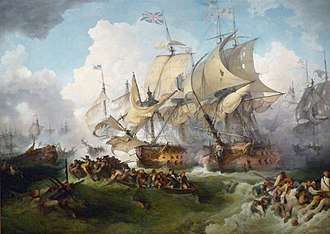HMS Queen Charlotte (1790)
HMS Queen Charlotte was a 100-gun first-rate ship of the line of the Royal Navy, launched on 15 April 1790 at Chatham. She was built to the draught of Royal George designed by Sir Edward Hunt, though with a modified armament.[1]
 Lord Howe's action, or the Glorious First of June by Philippe-Jacques de Loutherbourg, painted 1795, shows the two flagships engaged on 1 June 1794. Queen Charlotte is to the left and Montagne to the right. | |
| History | |
|---|---|
| Name: | HMS Queen Charlotte |
| Ordered: | 12 December 1782 |
| Builder: | Chatham Dockyard |
| Laid down: | 1 September 1785 |
| Launched: | 15 April 1790 |
| Completed: | 7 July 1790 |
| Fate: | Burned and exploded 17 March 1800 |
| General characteristics [1] | |
| Class and type: | 100-gun first-rate ship of the line |
| Tons burthen: | 2,286 |
| Length: | 190 ft (58 m) (gundeck) |
| Beam: | 52 ft 5.5 in (15.989 m) |
| Depth of hold: | 22 ft 4 in (6.81 m) |
| Sail plan: | Full-rigged ship |
| Armament: | |
In 1794 Queen Charlotte was the flagship of Admiral Lord Howe at the Battle of the Glorious First of June, and in 1795 she took part in the Battle of Groix.
Fate

At about 6am on 17 March 1800, whilst operating as the flagship of Vice-Admiral Lord Keith, Queen Charlotte was reconnoitering the island of Capraia, in the Tuscan Archipelago, when she caught fire. Keith was not aboard at the time and observed the disaster from the shore.[2]
The fire was believed to have resulted from someone having accidentally thrown loose hay on a match tub. Two or three American vessels lying at anchor off Leghorn were able to render assistance, losing several men in the effort as the vessel's guns cooked off in the heat. Captain A. Tod wrote several accounts of the disaster that he gave to sailors to give to the Admiralty should they survive. He himself perished with his ship. The crew was unable to extinguish the flames and at about 11am the ship blew up with the loss of 673 officers and men.[2]
Citations
- Lavery, Ships of the Line vol.1, p183.
- Gossett (1986), pp. 26–7.
References
- Gossett, William Patrick (1986). The lost ships of the Royal Navy, 1793–1900. Mansell. ISBN 0-7201-1816-6.
- Lavery, Brian (2003): The Ship of the Line - Volume 1: The development of the battlefleet 1650-1850. Conway Maritime Press. ISBN 0-85177-252-8.
- Winfield, Rif (2008): British Warships in the Age of Sail: 1793 - 1817. Seaforth Publishing. ISBN 978-1-84415-717-4.
External links

- Memorials and Monuments in Portsmouth (retrieved 27 September 2007).